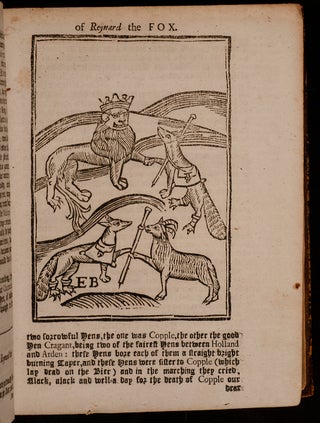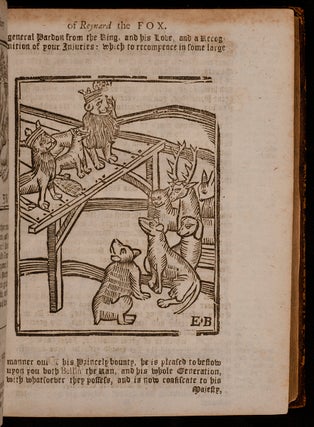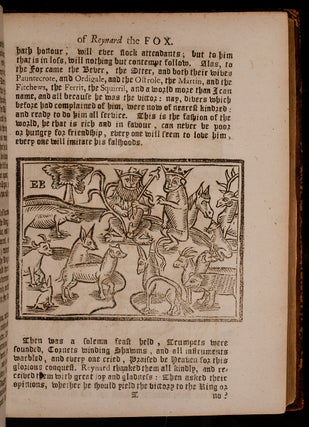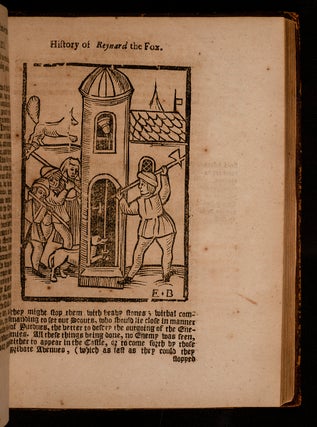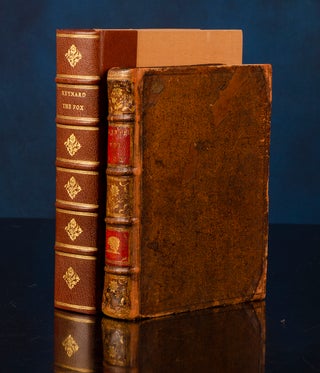Most Delectable History of Reynard the Fox, The
London: Printed by T. Ilive, for Edward Brewster, 1701. Item #00654
Early English Edition of the Reynard Fables
In it's Original Sprinkled Sheep Binding
[REYNARD THE FOX]. The Most Delectable History of Reynard the Fox. Newly Corrected and Purged, from all grossness in Phrase and Matter. Augmented and Enlarged with sundry Excellent Morals and Expositions upon every several Chapter. To which may now be added a Second Part of the said History: As also the Shifts of Reynardine the Son of Reynard the Fox, Together with his Life and Death, &c. London: Printed by T. Ilive, for Edward Brewster, 1701.
[Bound together with:]
The Most Pleasant and Delightful History of Reynard the Fox. The Second Part. Containing Much Matter of Pleasure and Content. Written For the Delight of young Men, Pleasure of the Aged, and Profit of all. To which is added many Excellent Morals. London: Printed by A.M. and R.R. for Edward Brewster, 1681.
[And:]
The Shifts of Reynardine The Son of Reynard the Fox, Or a Pleasant History of His Life and Death. Full of Variety, &c. And may fitly be applied to the Late Times. Now Published for the Reformation of Mens Manners. London: Printed by T.J. for Edward Brewster, and Thomas Passenger, 1684.
Three parts in one small quarto volume (7 5/16 x 5 9/16 inches; 186 x 141 mm.). [156], [2, table of contents], [2, publisher’s advertisements]; [111], [1, publisher’s advertisements]; [8], 160 pp. Mostly black letter, with titles and side notes in roman letter. Sixty-two woodcuts in the first part, printed from thirty-nine blocks, and fifteen woodcuts in the second part, five repeated, all repeats from the first part. Most cuts signed “E.B.” (Edward Brewster). Woodcut on C1 recto (Part I) printed upside down. Some browning, occasional light damp staining and soiling. Part I with tiny puncture marks in the lower blank margin through gathering I, just touching one letter in the imprint on the title-page, six small holes in I3 and one tiny hole in I4, causing loss of a couple of letters. Part III with paper flaw in the upper blank corner of A3 and A4, tiny tear (1/4 inch) in the lower blank margin of F4, and paper flaw in the lower blank corner of I2, none affecting text.
Contemporary sprinkled sheep. Covers ruled and decoratively tooled in blind, spine decoratively tooled in gilt in compartments with two red morocco gilt lettering labels. Some expert restoration to joints and corners. Armorial bookplate of Gloucester on front free endpaper. Bookplate of Hugh Cecil Lowther, 5th Earl of Lonsdale (1857-1944) on front pastedown (his sale, 12 July 1937, lot 445). An excellent copy. Housed in a felt-lined quarter brown morocco clamshell case, spine with five raised bands, decoratively tooled and lettered in gilt in comaprtments.
Reynard the Fox, “hero of several medieval European cycles of versified animal tales that satirize contemporary human society. Though Reynard is sly, amoral, cowardly, and self-seeking, he is still a sympathetic hero whose cunning is a necessity for survival. He symbolizes the triumph of craft over brute strength, usually personified by Isengrim, the greedy and dull-witted wolf. Some of cyclic stories collected around him, such as those telling of the wolf or bear fishing with his tail through a hole in the ice, are found throughout the world; others, like that of the sick lion cured by the wolf’s skin, are derived from Greco-Roman sources. The cycle arose in the area between Flanders and Germany in the 10th and 11th centuries when clerks began to forge Latin beast epics out of popular tales… The main literary tradition of Reynard the Fox descends from the extant French ‘branches’ of the Roman de Renart (about 30 in number, nearly 40,000 lines of verse). The facetious portrayal of rustic life, the camel as a papal legate speaking broken French, the animals riding on horses and recounting elaborate dreams all suggest the atmosphere of 13th-century France” (Merriam-Webster’s Encyclopedia of Literature).
“Caxton’s immediate successors as printers of the Historye of Reynart the Foxe, Wynkyn de Worde and Richard Pynson, both published illustrated editions using the same woodcuts. Although neither a de Worde nor a Pynson edition survives intact, there are fragments, and there is circumstantial evidence to show that a Wynkyn de Worde edition of about 1495 (or earlier) was illustrated by a series of 43 woodcuts…apparently newly made for that edition…The earliest nearly complete fully illustrated History of Reynard the Fox to come down to us probably dates from the period 1560-1586. It survives in a unique copy…sometimes described as the ‘Anonymous’ edition because it lacks the first few and the last few pages were we would expect to find the name of the printer and the place of publication. It contains 39 of the 43 Wynkyn de Worde cuts. To judge by their worn state…they had been much used since they were first made. This Anonymous edition also contains a series of 19 smaller, artistically inferior pictures…They too are quite worn and may date from soon after the earliest illustrated editions…I have ascribed this Anonymous edition to the period 1560-1586. It is therefore just possible that it is either the lost William Powell edition of 1560-1561 or the lost Edward Allde edition of 1586, for both of these are mentioned in the Stationer’s Register, but neither survives” (Kenneth Varty, Reynard, Renart, Reinaert and Other Foxes in Medieval England: The Iconographic Evidence (Amsterdam: 1999), pp. 98-99).
“From William Caxton’s first edition (1481) to Thomas Gaultier’s only edition (1550), the story is divided into 43 chapters. This may explain why the Wynkyn de Worde picture cycle contained 43 vertical cuts, though in fact some chapters were not illustrated, and some were illustrated with more than one picture. In the period before the appearance of the Anonymous edition we know…of only three illustrated editions: the one by Wynkyn de Worde sometime before or in 1495 and the other by him c. 1515; and the one by Richard Pynson somewhere between 1501 and 155. In the Anonymous edition (between 1560 and 1585) the story is divided into 58 chapters. This may account for the frequent repetition of the vertical cuts (as space-fillers) and even for the introduction and occasional repetition of the smaller horizontal cuts. For most of the seventeenth century, the story (now short-titled The Most Delectable History of Reynard the Fox) is divided into 25 chapters, but this does not result in any noticeable reduction in the number of cuts used of either the vertical or the horizontal kind, nor in the introduction of new illustrative material. In short, the same cuts go on in much the same order (apart from space-filler repetitions) illustrating the same episodes. The first seventeenth-century edition to continue this picture cycle tradition is Edward Allde’s (1620) followed by Elizabeth Allde’s (1629). It continues in the two editions published in 1640 by Richard Oulton, one for John Slater and the other for John Wright; also in the editions published by Jane Bell in 1650, 1654, and 1656; and in the first edition published by Edward Brewster in 1662. By this date the Wynkyn de Worde blocks had become so worn and damaged that it is not surprising to discover a totally new set closely modelled on them and on the sixteenth-century horizontals, and that this set should appear in an edition made for the publisher who last owned the de Worde blocks; that is, in Edward Brewster’s second edition in 1671 of The most Delectable History of Reynard the Fox…The forty different cuts which illustrate this edition all prominently display his initials EB. He published further illustrated editions in 1676, 1681, 1694, and 1701. In 1671 Brewster gave a new lease of life to the old picture cycle, and in 1672 he grafted new life onto the old story with A Continuation, Or Second Part Of The Most Pleasant and Delightful History of Reynard the Fox…In due course, this new story about Reynard was to attract new illustrations, but in this volume Brewster makes do with a sprinkling of fifteen cuts from his new cycle bearing the initials EB, and he uses them again in his 1676 edition of the old story (now called Part One) and in his 1681 edition of both Part One and Part Two.…In 1684 Brewster marketed a further sequel to this Continuation. Since Reynard was dead the chief role in this new story is given to one of his sons, the one called Reynardine. It is entitled The Shifts of Renardine The Son of Reynard the Fox…Edward Brewster was not the only late seventeenth-century publisher of the Beast Epic to feel the need to renew it. His contemporary John Shurley (sometimes spelled Shirley) also felt that need, and in 1681 he published his Most Delightful History of Reynard the Fox in Heroic Verse…Unlike other, earlier renovations of the story, it was never reprinted, perhaps because the verse form was unpopular and because the illustrations were poor and few” (Varty, pp. 254-257).
Brunet IV, cols. 1228-1229. Lowndes, p. 2076. Varty (Appendix Three: “A Short-Title List of All Extant Illustrated Histories of Reynard the Fox from Wynkyn de Worde (c. 1495) to A. Soulby (c. 1800) which are kept in United Kingdom libraries based on H. Menke, Bibliotheca Reinardiana”) 24, 18, and 21. Wing S3512 (Part II) and S3436 (Part III).
Price: $9,500.00

 I have been in the rare and antiquarian book business for over forty years; my family has been in the rare books business since 1876. Rare books are in my blood.
I have been in the rare and antiquarian book business for over forty years; my family has been in the rare books business since 1876. Rare books are in my blood.

